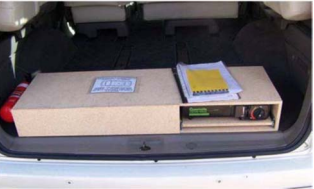This webpage provides requirements for imported people mover based campervans and converting the vehicle back to a passenger vehicle.
Background
For registration:
- any imported people mover based campervan - eg Nissan Elgrand and Toyota Estima, must meet the campervan requirements
- any modifications made to convert the campervan to a passenger vehicle must meet the passenger vehicle requirements.
Nissan Elgrand
Toyota Estima
Campervan requirements
The seating label required by Circular 0-4-12 Certification of Campervans and Motorhomes must be affixed to a permanent part of the vehicle’s structure.
Any seats in excess of the number on the Registered Automotive Workshop Scheme (RAWS) compliance plate shall not be provided with seatbelts, child-restraint anchorages or any other equipment that may imply that they are for use in transport. These excess seats are acceptable as convertible to sleeping accommodation.
Where the vehicle has been plated as having three seats and the right-hand outboard seat in the second row is nominated as the third seat, the left hand seat must be removed as well as the seatbelt for the former centre seat.
Where the vehicle has been plated as having four seats and the second row of seats could accommodate three passengers, only the two outboard seating positions are approved seating positions.
In this case, the centre position can remain without a seat belt, providing the seating label shows this seat is not to be used as a seating position whilst the vehicle is in motion.
The cooking facilities, storage, sleeping accommodation etc. should be secured to withstand a force of 10 times its weight and must be designed such that they do not dislodge during travel. They may be removable.

An unsecured camping stove and storage compartment, as shown above, is not an acceptable conversion
Passenger vehicle requirements
Conversion of the campervan to passenger vehicle requires the vehicle to meet all requirements listed in the form of a Statement of Requirements. The vehicle will also need to pass a roadworthiness inspection to enable registration to occur.
You will need to:
- apply to modify a light motor vehicle
- a statement of requirements will be issued by Vehicle Standards
- a report from a light vehicle engineering signatory (LVES) may also be required
- have a roadworthiness inspection.
Apply to modify a light vehicle
The engineering report if requested in the statement of requirements must be submitted to Vehicle Standards prior to the vehicle being booked and presented for the roadworthiness, which includes seating inspection for checking and verification.
When requested in the statement of requirements, an engineer’s report prepared by a LVES is required to show that the additional child restraint anchorages, seats, seat anchorages, seat belts and seat belt anchorages for seating positions not included in the RAWS certification, comply with the applicable Australian Design Rules (ADR) requirements.
All seat belts must be marked as complying with the Australian Design Rules (ADRs) or the ECE regulations with an 'E' marking. Seat belts marked as 'Domestic' are not acceptable; they are to be replaced with complying seat belts.
Where child restraint anchorages are mounted on the floor behind the seat, a LVES must address the strength of the seat back due to the loading of the child restraint strap on the top of the seat back.
In a vehicle fitted with seats that can be rotated to be either forward or rearward facing, a LVES must address the strength of the seat in both positions as well as the seat belt and anchorage requirements. Where there is no LVES report or seat belts for the seat in the rearward-facing position, the seat must be permanently locked in the forward-facing position.
Where the rear seats can accommodate three passengers, the centre seat may only be accepted if the buckle end of the lap belt is located on the anchorage within the left hand seating position. This anchorage must be certified as complying with the requirements of ADR 5/.. by an LVES. Otherwise, the centre seat in the second row shall have the seat belt removed and a label is required, stating that the position is not to be used whilst the vehicle is in motion.
If the vehicle is fitted with split second and third-row seats where different parts of the seats can be moved forward and backward independently of each other each row must be locked together to maintain the correct alignment.
Gross vehicle mass requirements
Some vehicles may exceed the gross vehicle mass (GVM) as stated on the RAWS compliance plate, even though the vehicle is equipped in accordance with the original vehicle’s seating capacity.
The GVM must equal or exceed the ‘Maximum Loaded Vehicle Mass’ as defined by the ADRs - ie the number of seating positions multiplied by the sum of 68 kg passenger mass plus 13.6 kg for luggage. A GVM upgrade requires the vehicle to meet all requirements listed in the Statement of Requirements and a report from a LVES.
Importation
For information regarding the importation of the vehicle and import approval conditions contact the Department of Infrastructure, Transport, Regional Development, Communications and the Arts on 1800 815 272 with the approval number or the vehicle identification number (VIN).
Vehicle Standards reference: MR1324.

